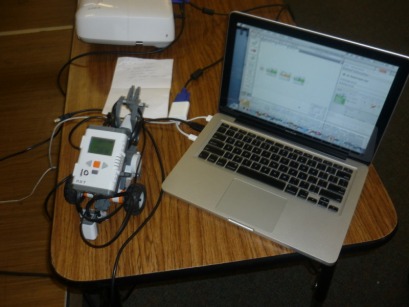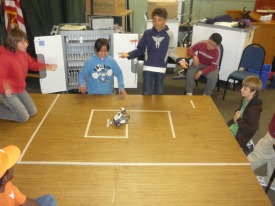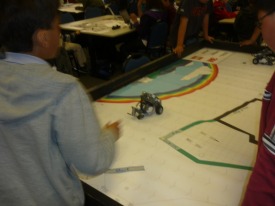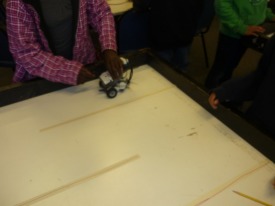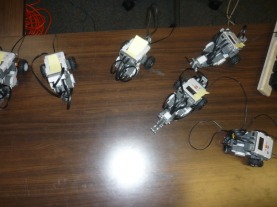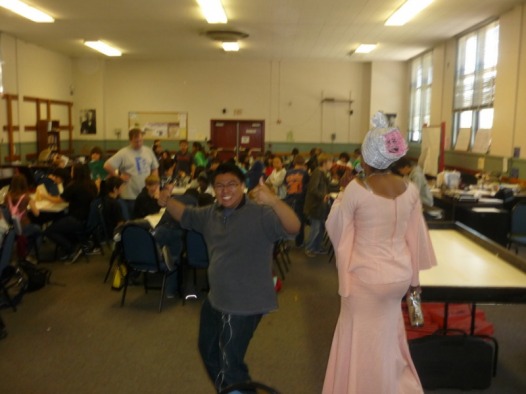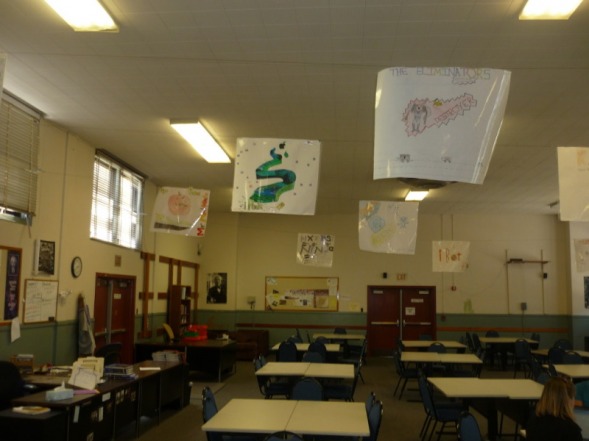Internship
For my internship, I worked at NEA Community Learning Center underneath Maafi Gueye and Paul Bentz. I was an assistant formally but I led and facilitated the LEGO Mindstorms robot programming and boat building seminars that were happening during my time there.
Daily Journal Entries
May 5th, 2010
Today was my first day of my internship. When I walked into the office, I had expected MaMaafi to hand me a stack of tests to grade, paperwork to file or someone to tutor but I was turned over to Paul and immediately began working on something more cooler. I followed Paul through the playground to this storage room and helped me bring ten orange toolboxes to the Tree, NEA's center of the center. He told that tomorrow I would be teaching sixth graders how to use the LEGO Mindstorms robot programming technology. They would need my help to complete the obstacle course we'd design for them.
Essentially, he handed me a toolbox complete with an assembled robot, his Macbook and told me to go play with my new toy. I was completely new to everything going on: I had done robot programming before and I had never used a Mac before. What made it more fun was Paul's unfamiliarity with either but it was actually pretty easy. Programming was a much simpler concept to understand once I had gotten my hands on the robot and had an hour or two to practice.
The clock was approaching 12:30, the end of the day, so I headed back to return my tools and check out. As soon as I was in front of her, MaMaafi said "Okay. What I need from you now is I need you to make a presentation to teach all sixty of the sixth graders how to use the program and the robots. I need basic movement, light sensor, touch sensor, the whole thing, understand?" Uhh, OKAY, you're funny! At least I got to borrow the robot and the Macbook for the rest of the day as I got my presentation ready for tomorrow.
Today was my first day of my internship. When I walked into the office, I had expected MaMaafi to hand me a stack of tests to grade, paperwork to file or someone to tutor but I was turned over to Paul and immediately began working on something more cooler. I followed Paul through the playground to this storage room and helped me bring ten orange toolboxes to the Tree, NEA's center of the center. He told that tomorrow I would be teaching sixth graders how to use the LEGO Mindstorms robot programming technology. They would need my help to complete the obstacle course we'd design for them.
Essentially, he handed me a toolbox complete with an assembled robot, his Macbook and told me to go play with my new toy. I was completely new to everything going on: I had done robot programming before and I had never used a Mac before. What made it more fun was Paul's unfamiliarity with either but it was actually pretty easy. Programming was a much simpler concept to understand once I had gotten my hands on the robot and had an hour or two to practice.
The clock was approaching 12:30, the end of the day, so I headed back to return my tools and check out. As soon as I was in front of her, MaMaafi said "Okay. What I need from you now is I need you to make a presentation to teach all sixty of the sixth graders how to use the program and the robots. I need basic movement, light sensor, touch sensor, the whole thing, understand?" Uhh, OKAY, you're funny! At least I got to borrow the robot and the Macbook for the rest of the day as I got my presentation ready for tomorrow.
May 6th, 2010
The next morning was pretty nerve wracking for me. I had my presentation, I had my robot and my Macbook and I knew how to use them but seeing sixty little people sit down in front of me and the projector was pretty daunting. Luckily, I've presented to groups before and I'm not the worst with kids. I covered all the topics MaMaafi asked for and she was great at keeping the room quiet (I don't remember the center being quiet when she was there though).
The biggest issue that arose was the light sensor on the robot. Admittedly, the touch senor was sketchy and had a delayed response as well but the light sensor straight up didn't work while I was presenting. I felt like an idiot and to make things worse, there was a kid in the group who had used the software before who seemed like he knew it better than I did (his solution actually didn't end up working though, *raspberry*). Thankfully, I realized the issue that was plaguing the light sensor.
To explain these issues, I need to explain how the light sensor works. The robot has an on-board computer that can be detached to function as a scanner in order to take light level readings. You hold the scanner over the point that you want the robot to detect. For our purposes, it was always a line. The point has to be distinguishable from its surroundings. Since we're dealing with light, that basically means that if the floor is white / beige, the line should be closer towards black. After you have the reading from the line, you go to the program and input the number into a function and then give the robot a command to perform after detecting the line. For the light sensor challenge, it was to stop and reverse. The issue I had had was that on the light sensor is a light. While taking the readings, the light isn't active. However, while the robot is running, the light is on by default. This completely confuses the robot because it lightens the floor that it's driving over which can cause your robot to stop early, late or not at all.
I returned to the crowd eager to show them what I had realized. After explaining to them what I just explained to you, I put all my faith into the robot and it fortunately drove up to line, noticed it and turn back. Success!
With that, MaMaafi and another facilitator took over the group as I sat on the sidelines. Time became an issue. The group was acting disrespectfully with MaMaafi and we all know what can come out of that. Luckily, the only outcome was a lot of shushing and a lot of time wasted. The kids ultimately regretted it. I don't quite understand the scheduling issues that were going on with it being testing week for some grades but not the others and how we fit into that but we took a break and went on a walk with the sixth graders. By the time we got back, it was approaching the end of the day, leaving the kids around an hour or so to familiarize themselves with the program and the equipment. It wasn't a lot of time but they were just so disruptive that it couldn't have been avoided, and thankfully, we still had all of Friday to follow up.
May 7th, 2010
Friday was the last day for the robot challenge; what a fun and hectic day. The bell struck 8 and we were ready to go. The groups were already assigned, they were sitting quietly (oh, how they learn quickly), they had seen the programs and they knew which challenge they were about to take on so with no time to waste, we started.
MaMaafi had an entire project based around the robot challenge planned. The kids had to get their robots to complete as many of the three challenges as they could, they had to document the programming they inputted, they had to make a PowerPoint presenting their work, they had to make a team mascot and logo and they had to market themselves via poster as their next big robot programming super-group. Okay, ya'll take care of that. I've got robots to look after.
We had four (and a half) challenges: a basic movement challenge, a more advanced movement challenge, the touch sensor challenge and the dreaded light sensor challenge. It was to my understanding that there was an extension of the basic movement challenge that required you to do the same thing on the track next to it except completely in reverse, from the end of the course back to the beginning, so I told a group later in the day to do it (and they succeeded) but MaMaafi refused to give them any extra credit. Poor guys. Anyhow...
We had twelve groups with eight Macbooks featuring the Mindstorms program so eight were allowed to program at once while the other four were relegated to only working on their PowerPoints and logos and such.
Everything was going great, at least for a while. I was running back and forth between groups keeping people on task, answering questions and helping groups with their programming by breaking down for them what they were telling the robot to do and how they might have better success if they tried it a different way. I was also handling complaints and requests to rotate groups.
All of a sudden, Paul's robots started running out of battery life. He had eight in use with two spare ones but the spares had died as well. We were stuck on seven robots and now had an issue with what robots should be assigned to which task because I had taken the computer out of one and attached it to another because I had expected the battery to be strong on the second one. It was important we had certain robots assigned to certain tasks because not all robots had a touch sensor or a light sensor so when the reassembled robot got out amongst the groups, organization began to fall apart. This was compounded by many of the groups complaining that they weren't getting enough time to do all the challenges because they were either stuck at a team logo / PowerPoint table or they were stuck with a robot meant for a challenge they had already completed. I called in all the groups and reassigned robots to challenges and I came up with a way to rotate groups so that it was more fair.
One of the main issues with the rotations was that some groups were stacked as far as team members go while other groups were not. It was evident in the point spread. Some groups had thirty, forty, or sixty points (accumulated from completing challenges, progressing in their PowerPoints or team logo / mascot / poster activities) while others had zero to fifteen. Grading all these groups on the same scale would spell giant F's for half the room. I decided that in order to balance the scores so that everyone does close to equally well on the project, I needed to keep the highest scoring groups in tables nine through twelve because then the low score groups could sit at tables one through eight the rest of the day and have a chance to program AND work on the other aspects of their projects while the high scoring groups could only do the latter. Despite more complaints from the teams being placed on the non-programming tables about the new system being unfair, I decided it was a good idea and after informing them that they were bound to get A's on the project, they didn't seem to mind how unfair it was at all.
The day was over, for the kids at least. Sam, who had joined me as a partner, and I had the honor of hanging up all of the posters the groups had made; they turned out really nice. We headed back to the MaMaafi's office because she had more work for Sam and because I thought I was finished. I asked her to sign off on my evaluation but we had a dispute over hours so I had to come back in next week with Sam to get another three completed. Hurray.
May 10th, 2010
Now was the start of the boat building process. I arrived at 8 o'clock at NEA and showed up to MaMaafi's physics class on their first day of boat design. Sam and I were first asked to head to where MaMaafi was keeping the cardboard for the boats and count up how much she had to distribute to the groups. We brought it into the room and were pleased to tell her that each group was going to get around five pieces of large cardboard to start out with.
She then taught them a lesson in buoyancy and hull design as a prelude to what they needed to research if they were going to come in prepared to work on Thursday.
We talked to the class about our experience boat building, where we started, the things they needed to consider and I gave a small explanation on density and why that, along with hull design, was crucial in the boat making process. With that, class was dismissed.
May 13th, 2010
Today was the last day of my internship so I was pretty excited. Sam and I gathered the cardboard we had found the other day and handed it out to the groups who began working immediately. They had a few jobs for the period. They had to sketch a design, figure out who was going to be in the boat and then start building because they had a very limited amount of time before the races.
I walked around and tried to give tips where I could. Some groups seemed harmonious while others were in disarray but I guess that's a phase in every group's lifespan. I tried reaching out more to the group that needed the most help. They made strong progress. The period ended before they got to cutting out their design, mainly due to a certain someone having an important meeting before class. The good news though was that the physics room was free second period and none of them had class so they continued working. Most of the same happened second period, even down to the fact that their work time was extended into third period as well. By that time though, I had to leave to go to Spanish class and that was it. My hours had been filled out.
Closing Report
Since I only worked at NEA for a combined total of two weeks, I didn’t really have daily duties. MaMaafi had new things for me to do every day which kept me on task and interested in the work I was set out to do.
My favorite experience would have to be on the last day of LEGO robot programming. None of the groups had finished a challenge yet; it seemed like they had been stumped by the software. The program Mindstorms uses is a large empty workspace that you can fill in with blocks. The blocks that we used represent movement, touch detection and light detection and each one has its own respective submenus for more advanced options. As I walking around helping out, I noticed a lot of unnecessary blocks. For example, one group had three movement blocks all moving forward for one second each instead of one block of forward movement for three seconds total. Eventually, all the groups began to get it but the first group who managed stood out to me like a bunch of little geniuses. They ran up to me holding their robot, “We got it! We got it!” so we rushed over to the first movement challenge and I recorded their triumph on camera. It was pretty suspenseful for a kids’ LEGO obstacle challenge; the reaction from me signing off on their paper was awesome. They went right back to work and I think this inspired the rest of the room to do their best too. Not soon after, everyone started completing challenges and before I knew it, I had someone nagging on me from every angle. It was insane.
The biggest obstacle I found was getting MaMaafi to finish the dang paperwork! Geeze! Just kidding; the biggest obstacle would have to have been my own fear of failure and of looking stupid in front of such a large group of people.
I liked my internship a lot. It turned out to be a lot more fun and fulfilling than I had expected in the beginning. After I first asked MaMaafi for help, we had the attitude of “Umm yeah, we’ll find you something, probably. Someone will need you for something, I think” which didn’t come off as an ideal internship, just being used, but I was short on time and this was my only realistic option. I’m so glad I took it. There were new, unexpected challenges every day and my brain was forced to think on its feet and come up with solutions very often. Although it was very chaotic during the challenges and tough being called out to for help every other moment, it was nice to know that I was the room’s go-to guy for most of their problems and questions. For me, it’s rewarding when sixty sixth graders know my name after just meeting me; most people have trouble with it for ages. I’ve gained a lot of confidence in myself from working with the software and equipment and with the kids and facilitators at NEA. Being a leader is something I’ve found that I really enjoy doing.
My favorite experience would have to be on the last day of LEGO robot programming. None of the groups had finished a challenge yet; it seemed like they had been stumped by the software. The program Mindstorms uses is a large empty workspace that you can fill in with blocks. The blocks that we used represent movement, touch detection and light detection and each one has its own respective submenus for more advanced options. As I walking around helping out, I noticed a lot of unnecessary blocks. For example, one group had three movement blocks all moving forward for one second each instead of one block of forward movement for three seconds total. Eventually, all the groups began to get it but the first group who managed stood out to me like a bunch of little geniuses. They ran up to me holding their robot, “We got it! We got it!” so we rushed over to the first movement challenge and I recorded their triumph on camera. It was pretty suspenseful for a kids’ LEGO obstacle challenge; the reaction from me signing off on their paper was awesome. They went right back to work and I think this inspired the rest of the room to do their best too. Not soon after, everyone started completing challenges and before I knew it, I had someone nagging on me from every angle. It was insane.
The biggest obstacle I found was getting MaMaafi to finish the dang paperwork! Geeze! Just kidding; the biggest obstacle would have to have been my own fear of failure and of looking stupid in front of such a large group of people.
I liked my internship a lot. It turned out to be a lot more fun and fulfilling than I had expected in the beginning. After I first asked MaMaafi for help, we had the attitude of “Umm yeah, we’ll find you something, probably. Someone will need you for something, I think” which didn’t come off as an ideal internship, just being used, but I was short on time and this was my only realistic option. I’m so glad I took it. There were new, unexpected challenges every day and my brain was forced to think on its feet and come up with solutions very often. Although it was very chaotic during the challenges and tough being called out to for help every other moment, it was nice to know that I was the room’s go-to guy for most of their problems and questions. For me, it’s rewarding when sixty sixth graders know my name after just meeting me; most people have trouble with it for ages. I’ve gained a lot of confidence in myself from working with the software and equipment and with the kids and facilitators at NEA. Being a leader is something I’ve found that I really enjoy doing.
Evaluation
| 001.jpg |
| 002.jpg |
| 003.jpg |
| 004.jpg |
| 005.jpg |
